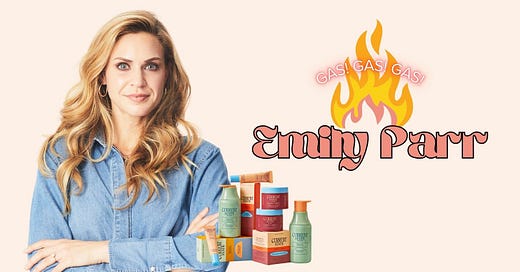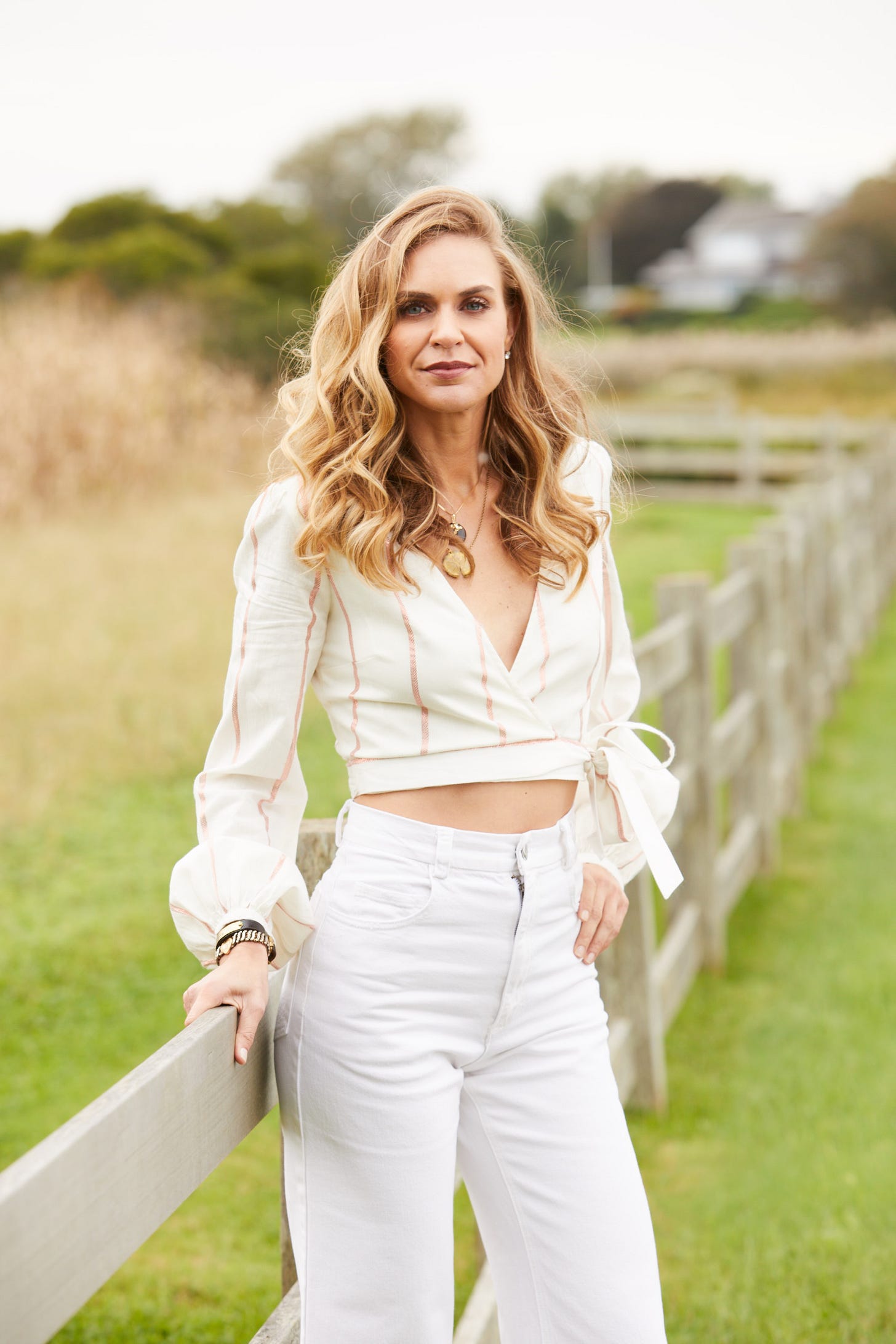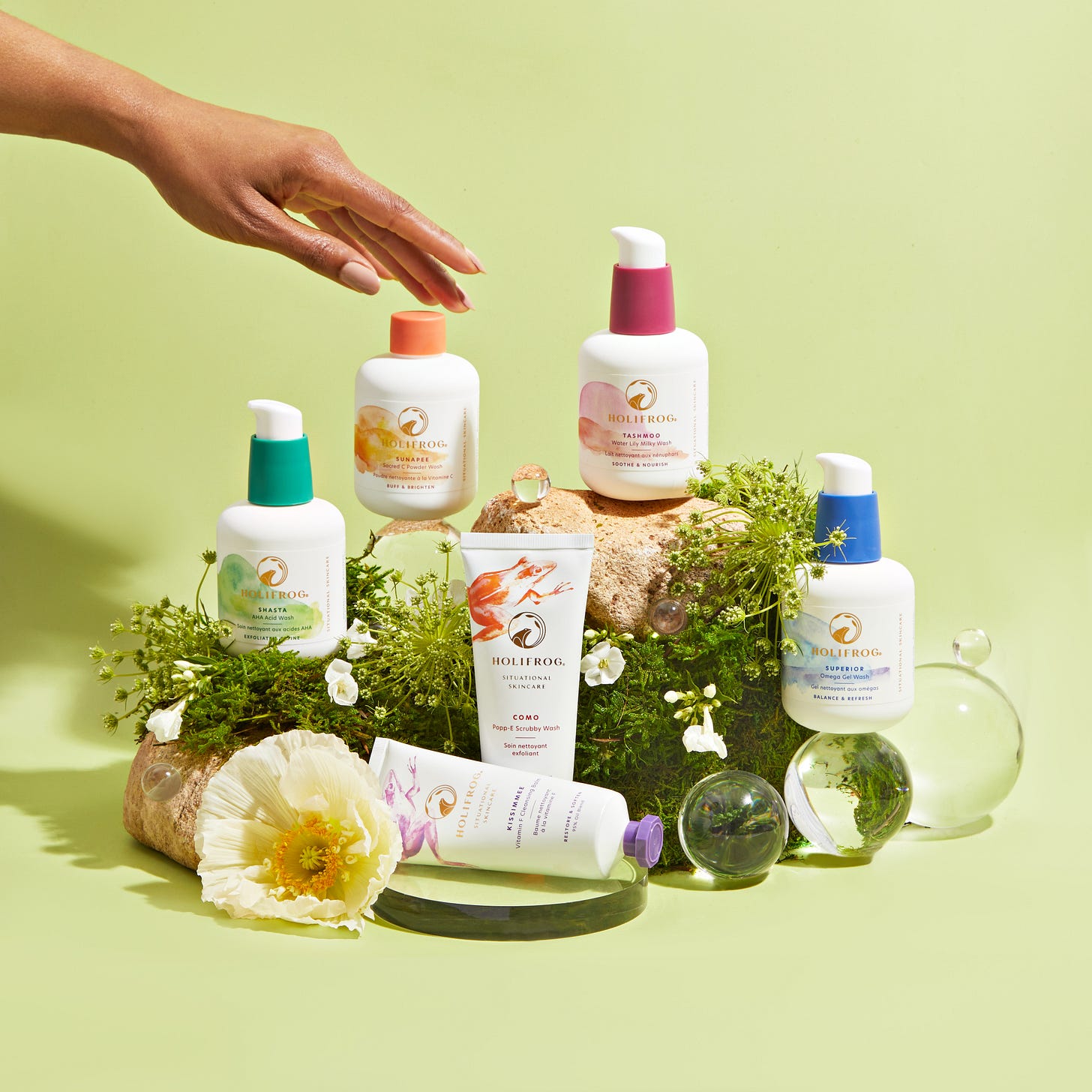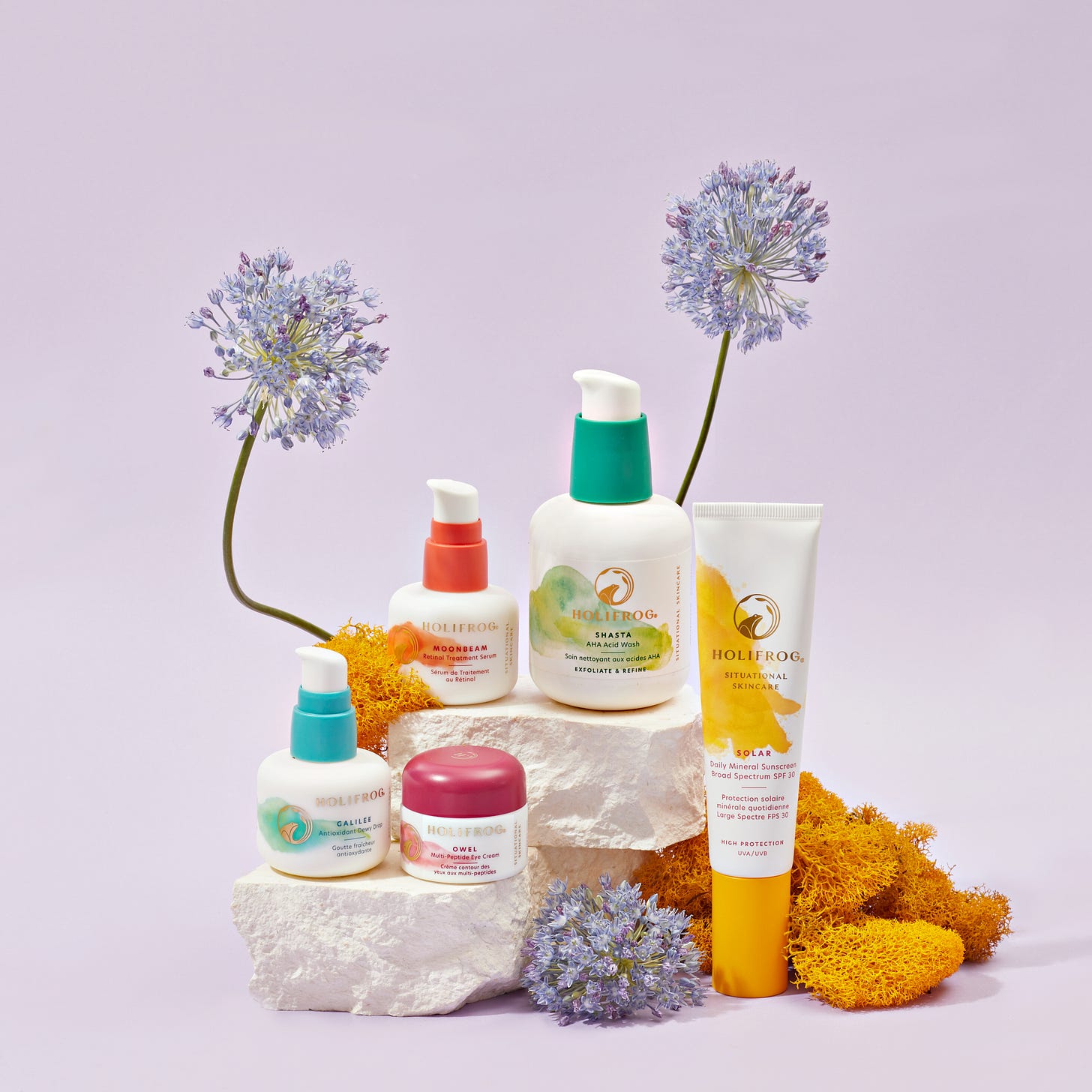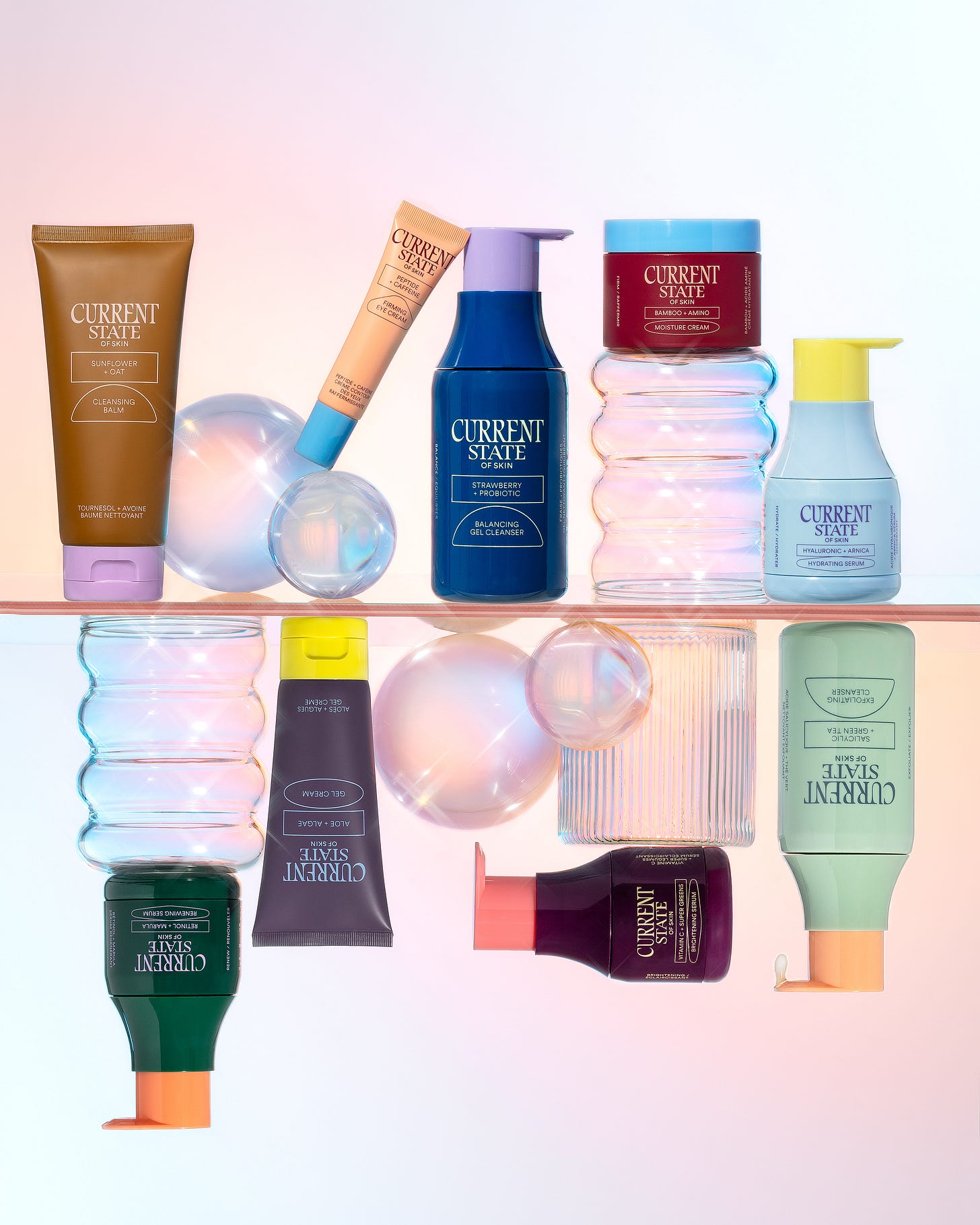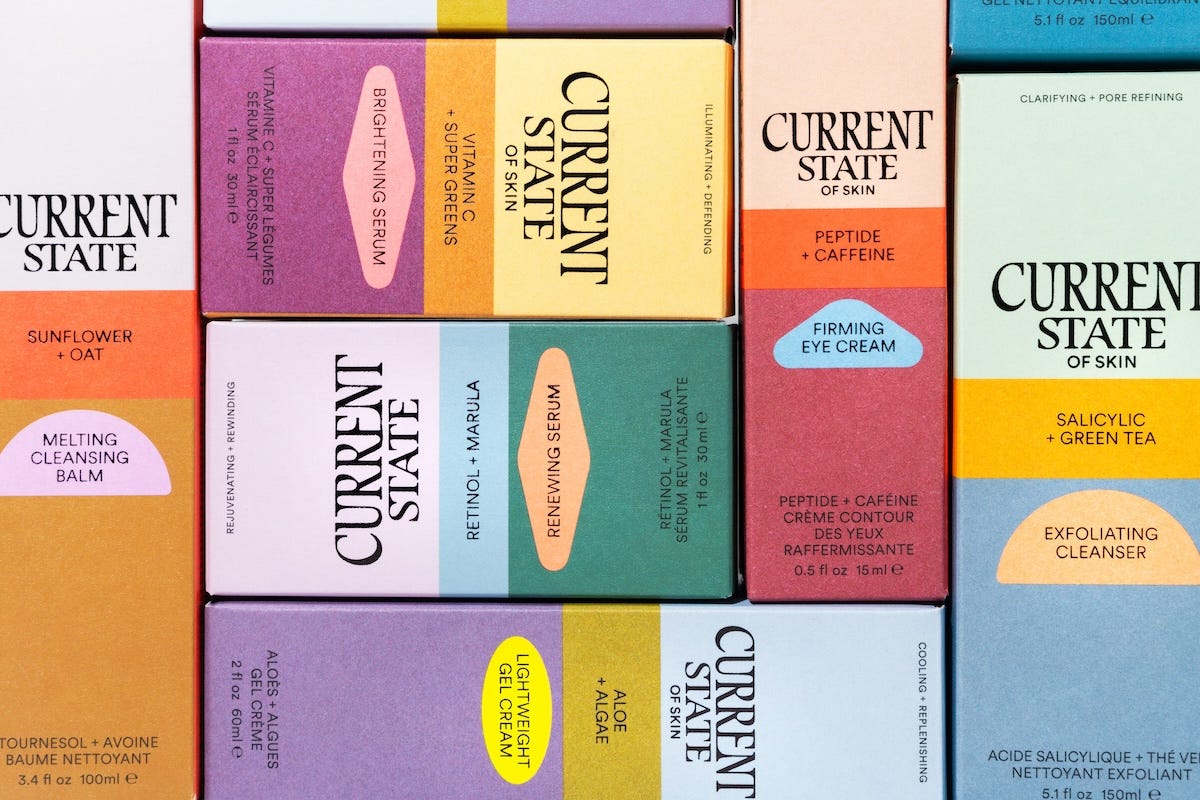Gas! Gas! Gas! Emily Parr
The co-founder of two viral beauty brands, Holifrog and Current State, shares her remarkable story of serial entrepreneurship.
Prefer to listen to the interview? Emily shares so much more in the audio version (if you don’t mind a little background noise, like my dog around minute 18, oops). Just play the above!
Emily Parr has started not one but three different businesses throughout her career. What started as a path in PR at Shoshanna, Vera Wang, and Equinox led to building her own beauty and wellness agency, Poke PR, in 2012. Inspired by the exciting process of helping ingredient-driven brands (like Drunk Elephant and Summer Fridays) explode into the mainstream, Parr shifted to creating two groundbreaking skincare lines with a business partner: Holifrog in 2019 and Current State in 2023.
With a baby on the way (she’s due this month!) and exciting plans for both brands in the year ahead, Parr is in for a very memorable 2025. Read about her wild professional journey, which involves green juice, Salma Hayek, and a meticulous eye for detail, and you’ll understand why the Martha’s Vineyard resident is such an incredibly successful business owner.
Emily, thank you so much for being on Fire Edits. Your career arc is really inspiring. I’d love to hear more about how it led to co-founding two successful beauty brands.
I’ve always been good at my job when I believe in what I'm doing. If I don't believe in it, I'm not going to excel. I went from working in-house for fashion brands, realizing I didn't really like fashion, to switching to wellness by working for Equinox. Launching a PR agency next happened in such an organic way.
In 2010, I became friends with Eric Helms, the owner of Juice Generation, a self-funded juice bar chain in the NYC area with about 30 locations. At the time, he had three locations inside three of the biggest, most highly-trafficked Equinox locations. Green juice was a novelty, and the only other juice bars were mom-and-pop niches—and none of them had PR.
I was very passionate about what Juice Generation was doing and wound up naturally getting press for it. I’d be on the phone with editors talking about Equinox’s fitness classes and say, “Hey, what do you think of kale? How do you refuel after a workout?” I liked spreading Eric’s mission.
He took me to dinner one day to thank me for helping him and said that he wanted to hire PR. I was like, “Great!” I started making introductions, and he met with all of them. A few weeks later, he came back to me and said, “I don't want any of them to do my PR. I want you.”
Now, I really liked my job. Equinox had so many dimensions; I couldn't imagine sitting there Monday through Friday pitching juices and smoothies. I explained that to Eric, and he said, “I don't need you to come in-house. You can keep your job at Equinox, and I'll pay you a retainer.” And that's how things began. I had two jobs, and it wasn't a secret. Even my boss at Equinox was like, “This is great! You’re being so entrepreneurial.”
About six months later, Salma Hayek, who had worked with Juice Generation and was involved in the juice business, was seeing all the press. This was the juice boom. The New York Times covered it on the front page of the Style section. Time magazine did two pages on Eric. I mean, this was big stuff. And who was the only one out there with the publicist? Juice Generation.
Salma called Eric and said, “I want Emily to take over the PR for my CVS pharmacy brand.” It was called Nuance Salma Hayek and launched about a year earlier. She wasn't happy with the way things were going, so she asked for my number. Well, I didn't get a call from her, but the head of PR at CVS called and said, “Since Salma wants you, we're coming to New York to meet you.”
Meanwhile, I didn’t have an office; I had a Gmail account. I met the head of CVS at a coffee shop in Midtown, bringing a binder of my press books. One thing led to another, and suddenly, CVS Pharmacy was my client.
At that point, I went to my Equinox boss and said, “This is an opportunity of a lifetime. I have to go.” She said, “Do you have an office? If not, you can work out of here for a couple of weeks while you figure this out.”
I had no idea what was about to happen. CVS asked for my address to send product samples. I gave them Equinox’s address and a giant truck showed up. I was getting cases of hundreds of SKUs. I went downstairs and gave them my apartment address instead, then ran home. They unloaded box after box after box—all stacked up to my ceiling.
I sent a photo to Eric. “Stay right there,” he said. He sent his juice trucks over with his guys who loaded it all up and brought it out to the juice commissary in Long Island City. They built a whole storage area for me. It was surreal.
To have someone like that, who just believes in you and trusts you—they give you a shot and keep making sure you’re successful. That’s why Eric is still one of my very best friends to this day, and it’s been about 15 years.
Yeah, I bet. He sounds incredible! What happened next?
I took the first year of Poke PR to focus on having a corporate client that had a celebrity attached to it. Juice Generation was my guardian angel—I always wanted to treat Eric with the utmost care, too.
When it was time to expand, I felt this itch. When you're an entrepreneur, you feel this, “OK, I'm comfortable now, and I'm ready for another layer of being scared.” I started poking around to find the next brand I’d want to represent and stumbled across Drunk Elephant on Twitter.
They hadn't launched yet. I went to their site, and it was just a landing page, but the design was really different. I reached out to the founder, not knowing anything about her product, and she emailed me right back. “You sound right up my alley, but I've already hired a PR agency to start with my social media.” I thought, “That's a weird move,” and found out she retained a huge, old-school PR agency. I thought, I'm going to stay in touch with this woman—she's going to end up not being happy with them.
Over the next few months, I talked about her brand with editors, asking them, “Oh, have you heard of Drunk Elephant? What do you think?” I eventually met the founder and really liked her. A couple of months later, she texted me, “Hey, I just landed in New York. Do you want to come meet me for dinner?” It was a Sunday night, and I was in my bed in the West Village.
I got out of bed, put on some makeup and presentable clothes, then trekked to the Upper East Side. I had already eaten dinner, so I sat there at the bar with her as she ate, and I was able to land her as a client.
From that point on, I had made my niche an area of emerging, founder-led, ingredient-driven brands. I found the clients that I wanted to work with: Briogeo, Summer Fridays, Ilia, Farmacy, BeautyCounter, RMS, Kitsch… just so many awesome brands.
Again, an itch popped up in 2018. I thought, God, all of my brands are growing up—they're all getting primed and ready to sell. Am I going to do this for the rest of my life? Just keep finding brands that I take under my wing? They all became my passion project, but they weren’t mine. I’d work with them during the fun, hard years of groundwork and brand-building, then eventually, they’d hire big C-suite teams and start spending tons of money on strategic marketing plans. It was a fun suck, and the spirit of what I liked about the brand slowly left.
My first thought on what to do next was to invest in some of these brands.
Another thought was I could become a bigger agency and start taking on Elizabeth Arden, Claudepot, Revlon, Almay—all these big names who were already reaching out to me. Maybe I should just change my philosophy on the types of brands I represent.
My third thought was about how my now-business partner, Majeed Hemmat, had come to me and said, “We should launch a brand together.” Maybe I should consider this a little more seriously.
I knew so much about formulas, ingredients, and storytelling. As a publicist, you're a storyteller by nature. I was always so curious about the ingredients in each great brand I represented. Some would be launching a vitamin C serum at the exact same time, so I would study those three different formulas and learn what made each unique and distinct. I wanted to understand those salient characteristics and why editors seemed to cling to one over the others.
So, that's the direction I ended up going in.
Initially, Majeed wanted to launch with a line of cleansers, but I wasn't sold on it. Once I took a couple of months to story-tell in my head though, I noticed something was going on in the cleansing category. After calling labs and speaking to chemists, I learned that cleansers were a stepchild in the beauty industry. They were just water and surfactants—no different than your average detergent. No one was really putting any money, time, or care into them.
Now, I’m a very active person who works out a few times a day. I do my skincare routine at least three times a day, and I started realizing that the skin issues I was experiencing were due to a high level of surfactants in my face cleanser. It wasn't the ingredients themselves because I knew the ingredients. It was the percentage of them, which you don't know as a consumer. I was like, “Oh my God, these brands are loading 60% surfactant into their cleansers, and that’s what’s wreaking havoc on my skin!”
So, that's how we launched our first brand, Holifrog. It became this situational cleansing brand.
You’ve pioneered “situational skincare,” and it’s such a great concept.
Well, it's very intuitive. It made sense to me in the framework of: “I don't need a foamy, lathery cleanser when I first wake up in the morning. I just want something nourishing and creamy and light to get any eye crusties and drool off my face, which is a very different need than what I'm looking for at the end of the day. That’s when I need to double cleanse or use something that has much more of a lather.”
After launching Holifrog at the end of 2019, you followed it up with Current State in February 2023. Why co-found a second beauty brand?
I come from a mass-market background, and Majeed and I had always said we eventually wanted in on it. When we started Holifrog, there was no action in the that market, but there was so much to explore in the premium category.
It also made sense for us to start with a premium brand before launching something mass market. We learned about the cost of goods, suppliers, raw materials, and had a lot more wiggle room in terms of margins.
By the time we were asking, “OK, now how do we do this at $20 or less for retail?”, we had a good handle on things. We knew what labs and raw materials we could and couldn’t use.
Plus, no matter how much you try to convince someone about the major differences in the formulaic properties, there will always be people who don’t care. They don't care that one form of vitamin C is tens of dollars per kilo versus $800 per kilo. They want a cleanser that's $12.99. Like, there are one-percenters out there who are not spending $36 on a cleanser. So, I wanted to create a brand that could sit in Walmart but it looks like it could sit in Sephora.
The packaging of Current State is beautiful. Can you give us a preview of how big Holifrog and Current State are right now?
Holifrog is having success in facial bars and medical spas, like FACE FOUNDRIÉ and Heyday Skincare. We didn't intend for that to happen, but we fit a crossroad of really thoughtful formulas and clinically effective ingredients that you don't have to worry about consumers not wanting on their skin. So, Holifrog is in the retail sections of these spas when you walk in, but it’s also used in their treatments. It’s expanding in that direction.
Current State launched and Walmart immediately wanted to get behind the brand. It’s in 2,000 stores now, and we just launched mini sizes in a discovery section of Walmart called Beauty Finds.
We were so fortunate and so lucky that Walmart reached out to us a month after launch, but the work just begins at that point. You can't sit on all those shelves and not do anything to support your brand—at the end of the day, the retailer expects you to bring your customers in to buy your product. It's a lot of thinking and takes a lot of money (there are so many costs associated with being in a large retailer). So, we're in the process of fundraising right now.
What’s the key difference between owning a PR agency versus a beauty brand?
Having a PR agency was never easy, but I had been doing it and navigating the shifts in media for so long that I just rolled with the tides and grabbed onto them. When owning a brand, you're constantly at the whim of retailers who are changing their visions and approaches. They're reporting earnings that are down or high, and buyers change—it’s like playing musical chairs. There's so much out of your control.
Another difference: As a PR person, I was constantly like, “Don't involve me in your marketing meetings. That’s not my job. And why do you always want me to promote your sales? That's not why I'm here. You go promote your sales.” You know what I mean?
But, being a brand founder, that’s the world right now. You need to own your growth, and the only way to do that is by being out there, building your audience, and keeping them happy.
What are you working on now?
We're definitely working on another category for Current State, and eventually, we’ll be launching hair care. We're just trying to slot it in where it makes sense. The resounding theme of a lot of our conversations is: “We’ve barely marketed skincare, so stay focused and build our customer base before we introduce a new category.”
The hair care bottles make me so excited, though—they're beautiful, fully designed, and formulated. But the launch isn’t happening, so I have to put them away for now and temper my excitement.
Where do you look for creative inspo?
When we started working on the color palette for Current State's packaging, I told our branding agency, “I like the color combinations of my On running sneakers. I like how there's a bold color with a bright color and a grounding color. Like, cantaloupe with oatmeal and plum.” That informed the direction: A lot of color.
The inspiration for Current State’s storytelling came from the food industry. We created something called the “Current Core” with six skincare “food groups,” like the food pyramid. A lot of the key ingredients fall within those categories, and there's an icon that represents each one of them. That came to me from restaurant menus with the little key on the bottom that tells you what is gluten-free, dairy-free, or vegan.
Look, I'm a super-wellness person! Right there, those two analogies are from running shoes and menus.
What are you most proud of in your career to date?
Every day brings a set of its own challenges; no part of my career has been easy. It wasn't easy when I worked in-house for other companies dealing with a boss I didn’t agree with. Then, having a PR agency, if I had 8 to 10 clients, I always felt like I had 8 to 10 bosses. Owning a brand, you're at the mercy of your retailer or customers.
So, I think it's really important to stay true to who you are and just follow your gut.
I'm an impulsive person, and there will be situations where a retailer may say something about our awareness level, suggesting to bring on a celebrity as a brand ambassador. There are so many people out there who will do that. But, you have to think about how that will look in the long run.
Take a step back first and look at the foundation of your brand before you start piling money on top. It may take more time to get to where you need to go, but you’ll get there.
What’s some advice you’d give to someone who’d love to follow in your footsteps?
Talk to as many people as possible within the industry you’re looking to get into—and in different areas.
If you want to launch a product, talk to a branding or marketing person, don't just talk to the founder. On the one hand, they know a lot, but what worked for them when they started 12 years ago might not necessarily apply today. In fact, I know it won’t. The founder is also likely not involved in the nitty gritty anymore. So, get perspectives from different areas of the industry on how best to approach it.
Anything else that you’d like to share with our readers?
There's a lot of talk out there about manifesting. I'm not very good at it, but Cassandra Thurswell, the founder of Kitsch, has a great little manifesting hack that I just started: She sends herself letters from her former self, like “Congratulations on getting into Target!”
This morning, I was like, OK, as I'm sitting here drinking my coffee and reading headlines, I'm going to send myself emails from my former self and start filing them away. Just small wins every day. Hopefully, when I look back on those one day, I can say, “Wow, this did happen, and so did this.”
It's easy to get down in this industry—when you look around, there are so many brands that feel 10 steps ahead of you. You’ve got to find little ways to keep yourself feeling positive.


